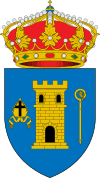Castellbisbal
Castellbisbal (Catalan pronunciation: [kəsˌteʎβizˈβal]) is a municipality in the comarca of Vallès Occidental in Catalonia. It is situated on the left bank of the Llobregat river at its confluence with the Rubí river. The town is served by the A-7 autopista, the main N-II road and the RENFE railway line R4 between Barcelona and València.
Castellbisbal | |
|---|---|
 Coat of arms | |
 Castellbisbal Location in Catalonia | |
| Coordinates: 41.476°N 1.983°E | |
| Country | |
| Autonomous community | |
| Province | Barcelona |
| Comarca | Vallès Occidental |
| Government | |
| • Mayor | Joan Playà Guirado (2015)[1] |
| Area | |
| • Total | 31.0 km2 (12.0 sq mi) |
| Elevation | 132 m (433 ft) |
| Population (2018)[3] | |
| • Total | 12,332 |
| • Density | 400/km2 (1,000/sq mi) |
| Demonym(s) | Castellbisbalenc |
| Website | www |
The remains of the Castellbisbal castle are visible on a hill near to the actual urban centre, while the surviving portion of the Pont del Diable ("Devil's Bridge") across the Llobregat river with its triumphal arch illustrates the historical importance of the town on the Via Augusta. The parish church of Sant Vincenç dates from the sixteenth century, while a Romanesque chapel (12th century) is in Can Pederol de Baix.
GDP_nominal_per_capita = 86.700 € ($99,120) [4]
References
- "Ajuntament de Castellbisbal". Generalitat of Catalonia. Retrieved 2015-11-13.
- "El municipi en xifres: Castellbisbal". Statistical Institute of Catalonia. Retrieved 2015-11-23.
- Municipal Register of Spain 2018. National Statistics Institute.
- https://www.ara.cat/economia/Ribera-Ebre-comarca-catalana-renda-capita_0_2145985530.html
- Panareda Clopés, Josep Maria; Rios Calvet, Jaume; Rabella Vives, Josep Maria (1989). Guia de Catalunya, Barcelona: Caixa de Catalunya. ISBN 84-87135-02-1 (Catalan).
.svg.png)